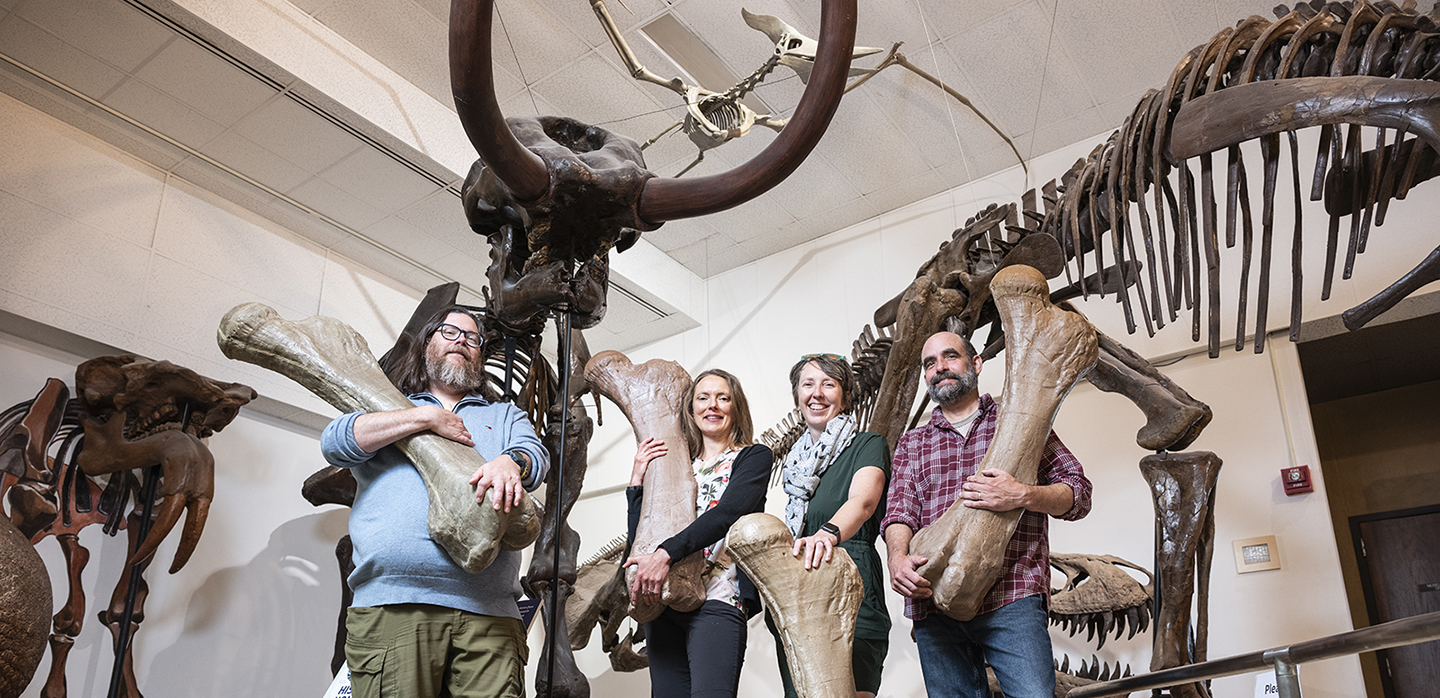
Fabulous Fossils
The rock stars at the UW Geology Museum find the stories behind the stones.
In a plastic bag in his office, Rich Slaughter keeps a collection of coins adding up to $5.89.
Arguably, it’s not the most important gift that the UW’s Geology Museum has ever received. Certainly, it isn’t the biggest, either by volume or mass or financial value. But the story behind it makes it among the most valued, at least to Slaughter, who’s been the museum’s director since 2004. The bag of change is the only monetary gift he ever felt so strongly about that he decided the museum should preserve it. (1)
“It’s from a kid who, this was their piggy bank, basically,” he says, “and I always wanted to hold on to that. So when it came time to do the end-of-the-month accounting, I put in my own $5.89 so I could preserve this original money. It’s very sweet.”
Stones, we’re told, are axiomatically unfeeling, but the Geology Museum — the UW’s repository for and shrine to stones — is a sentimental place. It was born by decree of the UW Board of Regents on October 7, 1848, and for most of its 175 years, it had only one assigned staff member at a time. That person devoted himself or herself not only to the collection and study of rocks, but also to their interpretation: to discovering and sharing what those rocks mean. Since Slaughter took over the directorship, the museum staff has slowly grown to four full-time employees. Each new person has increased the museum’s collection of treasures — and not just by adding literal gems, but by increasing its store of stories.
Rich Is Rich
When I met with Rich Slaughter in his office, it was March, and Slaughter was trying to solve a problem. The museum wanted to acquire a meteorite, and not just any meteorite: the first ever discovered in Dane County. Called the Vienna meteorite (2), it weighs in at 110 pounds, the largest iron meteorite discovered in the United States since 1981. The museum wanted it — and wanted to have it in time to put it on display at a UW–Madison open house in early April. But the deal was not yet complete.
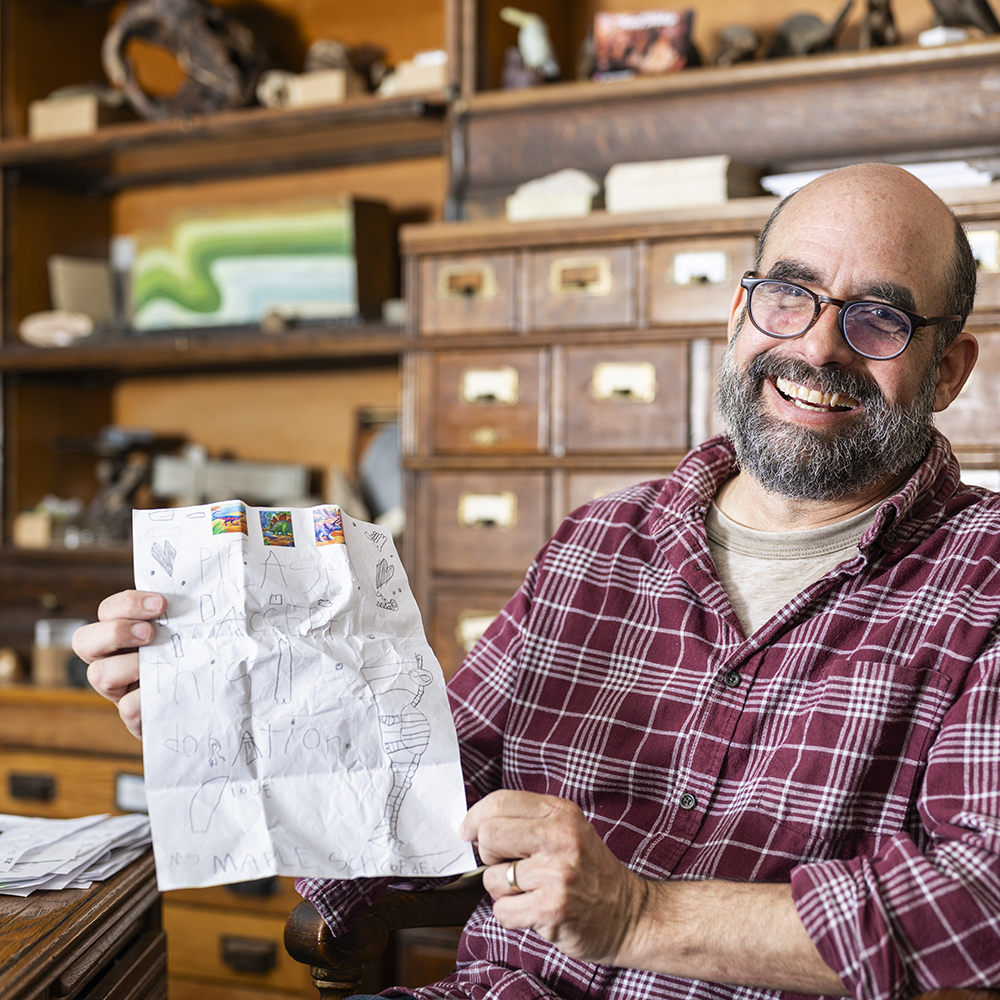
Slaughter holds up a letter that accompanied a donation from one of the museum’s fans. Slaughter’s office collection includes coins and other objects given by children and visitors.
“Right now, we’re about $30,000 short,” Slaughter told me. That $30,000 is the equivalent of 5,094 piggy banks (3), and with only a few weeks to go, the museum didn’t have time for 5,094 piggy banks. It was taking a lot of special effort to land the meteorite.
“I’m optimistic,” said Slaughter, “though I’m running on fumes at this point. The base work doesn’t go away.”
As director of the Geology Museum and Sherry Lesar Distinguished Chair of Geological Wonder, Slaughter has a wealth of base work. He oversees the staff and the collection, and he meets with donors — whether they’re giving money or objects. He also manages the sales case in the museum’s gift shop, and he examines rocks and stones and putative fossils from people who are curious to know what their objects are.
“There's a fountain in the courtyard. I wake it up in the spring, and I shut it down in the fall. All of the coins, I have them. ... I keep track of the wishes.”
“Every week we identify objects for the general public,” says Slaughter. “In well over 90 percent of the cases, people think they have meteorites. They do not. Or they suspect they have dinosaur eggs. They do not.”
Few of his duties are particularly remunerative, though some add to his collection of treasures.
“This is a secret,” he says. “No one really knows I do it, but there’s a fountain in the courtyard [of Weeks Hall for Geological Sciences]. I wake it up in the spring, and I shut it down in the fall. All of the coins, I have them. I keep track of all the pennies. I keep track of the wishes.”
Slaughter keeps track of a lot more than that. His office is the repository of the mementos that the museum and its staff have amassed. He has a microscope that belonged to former UW president Charles Van Hise 1879, 1880, MS1882, PhD1892. He has cabinets full of index cards and bits of rock and mineral. And on a sheet of white foam, under a dish towel, he had the Vienna meteorite, waiting to become official UW property.
In essence, Slaughter’s office is a museum to the Geology Museum.
The museum’s longest-tenured current employee, Slaughter came to the UW in 2001 to join legendary director Klaus Westphal, who had run the place for 34 years. Geology Museum staff, Slaughter says, “have longer tenures than most.” And he’s well aware of the rich history that lies in his charge.
The Geology Museum was created by order of the UW Regents at the board’s very first meeting (4). In its century and three-quarters, it’s had six homes: North Hall, when that was the UW’s only building; South Hall; University Hall; Old Science Hall, until it burned down in 1884, taking the museum collection with it; the current Science Hall, where it resided from 1888 until 1980; and Weeks Hall, where it has spent the last 44 years.
Last year, the museum topped 60,000 visitors: individuals and families wandering through, college students taking a class (Slaughter estimates that about a tenth of the undergraduates in any given year have a class session in the museum), and about 10,000 Wisconsin grade-schoolers on guided tours.
“They love the dinosaurs, the mastodon, the meteorites, and the glowing rocks,” Slaughter says. “You can rest assured, if you’re dealing with 50 second-graders from Madison, statistically speaking, some of those children have never been in the same room as a dinosaur. We’re in the inspiration business.”
And when May rolled around and this year’s elementary school field trips began arriving, the Vienna meteorite was there to inspire them. Optimism paid off, as did more than half a dozen donors.
Slaughter’s work is rich in labor, rich in variety, and rich in problems. And he wants to keep it all to himself.
“I don’t want to speak too highly of the job because I don’t want the competition,” he says. “I’ve got a great thing going. I don’t want to lose this sweet gig.”
Brooke Makes Marvels
Brooke Norsted MS’03 likes to talk about rocks.
“It’s the stories you can tell,” she says. “That’s what I still love about geology, that you could look at a road cut or at a mountain range, or at an individual rock, and there are clues that are telling us how different that place used to be.”
Norsted is the museum’s associate director, and she specializes in public outreach — in storytelling. She joined the team in 2004, right after she graduated.
“I approached Rich when he was just becoming the director, and I said, ‘Do you know of any science outreach-y jobs in Madison? Any tips?’ ” she says. “And he was like, ‘Well, I’ve got a few months of grant funding. Would you like a job here?’ And that was 20 years ago. We squeezed a lot out of those few months.”
Norsted has spent her life squeezing as much as she can out of opportunities. She grew up in Anchorage, Alaska, and attended a high school that offered her two years of geology classes. She earned a bachelor’s at Gustavus Adolphus College in Saint Peter, Minnesota, but before she committed to graduate school, she spent a year teaching preschool.
“I love Montessori philosophy, but I learned preschool was not the level at which I wanted to teach. There’s very little geology,” she says. “Though kids love rocks.”
While a grad student, she became a tour guide in the Geology Museum, where she spent her days talking to kids about volcanoes and dinosaurs. “It would fill my cup,” she says, “[and] recharge me to get back into my research.” And it helped point out that she wanted to be in the inspiration business: to marry geology with the chance to tell stories to children.
It also introduced her to a hero: Marvel Ings ’38.
Ings also loved the Geology Museum, just several decades before Norsted came along. From 1939 to 1942, Ings served as director — and she changed the museum’s direction.
Early on, the Geology Museum was the domain of the university’s greatest thinkers: Roland Irving, who helped establish the practice of petrography (writing detailed descriptions of rocks); Gilbert Raasch ’29, PhD’46, who was the state’s preeminent paleontologist; Charles Van Hise, who earned the UW’s first doctorate (5).
But if those scientists brought academic weight, Ings offered pizzazz. She was determined that the museum should be popular, especially with children, in an age when museums were usually oriented toward adults. When she took the director job, her hiring did not receive universal acclaim (6). Very few women ran natural history museums in the early 20th century, and of them, Ings was the only one who didn’t have a degree in the sciences: her bachelor’s was in journalism.
This meant Ings knew how to work the media. “Museum Stones Tell Stories Thanks to Woman Curator,” wrote the Milwaukee Journal. She crafted her own children’s book (7), Ram-for-inkus. And she took the museum’s collections out of their cases.
“She went to storefronts on State Street and asked if she could put exhibits in to help share information about geology with the public,” says Norsted, who found Ings inspirational. Norsted created a museum story time for children, “a tip of the hat to Marvel,” she says. The associate director even dressed as Ings for Halloween, though the costume must have required some explaining (8).
“She was just a classy lady,” says Norsted. “I admire her.”
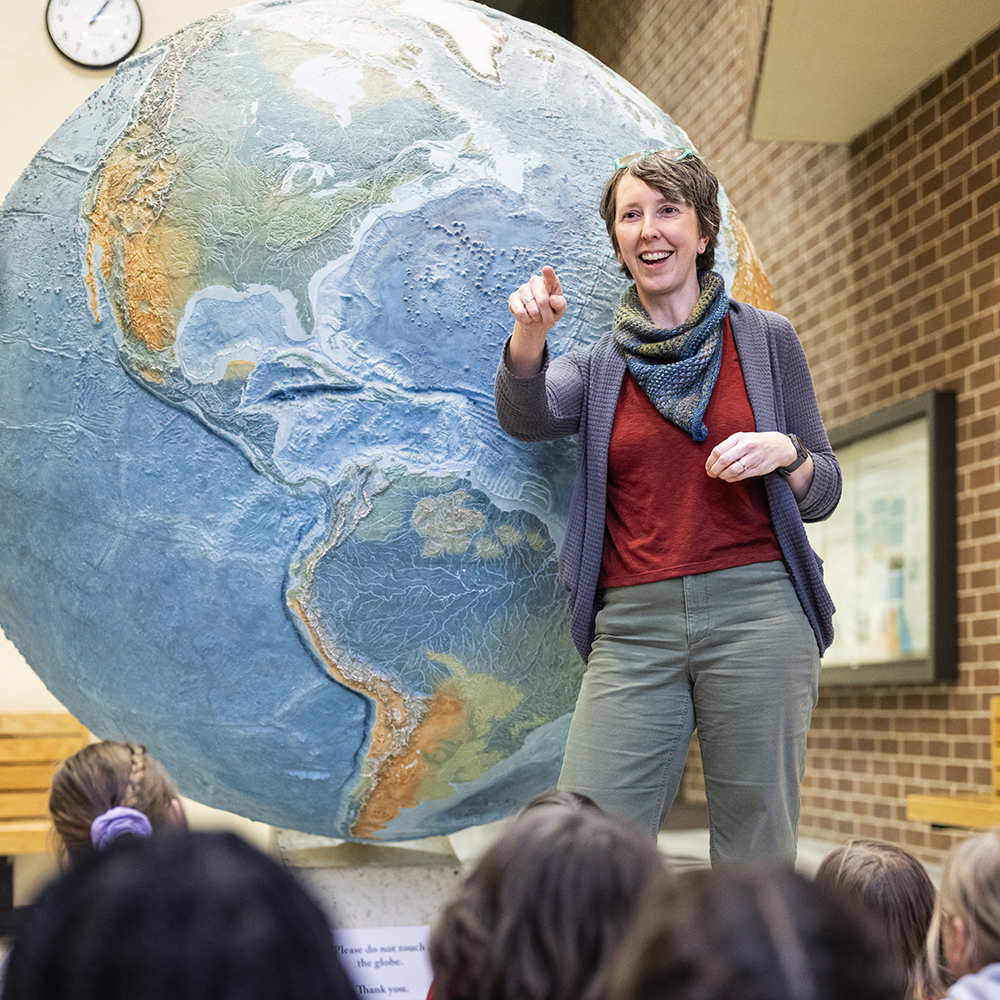
Norsted teaches museum visitors about concepts such as “deep time,” the span of billions of years that stretch back to Earth’s beginning.
Norsted carries on Ings’s work, training museum guides, engaging with visitors. Her current focus includes finding ways to convey the concept of “deep time” — the very long time spans that geology covers. She’s been working on the best analogies to illustrate how old the world really is. She has kids stand up straight: their feet are the formation of Earth, 4.56 billion years ago; the top of their head is the present.
“I ask people when dinosaurs went extinct, and someone will say 65 million years ago,” she says. “If there’s one number people can pull out of the ether, it’s 65 million years ago.”
Then she asks: where on the bodily timeline did dinosaurs go extinct? People frequently point to their belly button. The right answer is an inch down from the top of their head.
“I get to gently mock people for their math skills,” she says. “But everything that’s a fossil — T. rex and trilobites and mammoths — they’re all on the head. From chin to knee, the earth is a slime world.”
The entire history of the museum itself, at a mere 175 years, wouldn’t penetrate the hair. But then Norsted is pleased to be able to make the vast scope of her science more accessible.
“It’s hard to wrap your head around 4.56 billion years,” she says. “But I feel like that’s something that in the arc of my career, I’m in a place now where I’ve had a lot of time to experiment, and where I get to really share what I’ve learned.”
Dave Digs Dinosaurs
Dave Lovelace PhD’12 wants you to know that he’s not just a dinosaur guy.
“I study a lot of things,” says the museum scientist. “I’d really frame it as, I’m a paleo-ecologist. I’m more of a generalist than I am a specialist, and that’s because I like to blend what I can interpret from the rock record and the fossil record.”
Like Norsted, he enjoys reading rocks: the cataclysms and crises, the rise and fall of different species. “It’s like a novel,” he says. “I am a glorified storyteller.”
Still, Lovelace does study dinosaurs, and right now, he’s eager to share the name of one that he and his students discovered in Wyoming. But he has to practice patience. To name his dinosaur, Lovelace must wait for official publication of a study he led. “Until it’s published, the name isn’t official,” he says. “Remember the example of the Supersaurus.”
The Supersaurus is a sauropod (9) that was prematurely unveiled in 1973 by paleontologists who used that name informally: saurus for dinosaur and super because the dinosaur was really large. But then a journal (10) picked up the story and ran the name, and once it was in print, the name stuck, taxonomists be damned. So Lovelace is discreet, even with On Wisconsin.
This won’t be the first extinct creature he’s helped name. Recently, he was part of the crew that uncovered a previously unknown reptile called Beesiiwo cooowuse, announced in April 2023. B. cooowuse is a species of rhynchosaur, its name coming from the Arapahoe language and translating as “big lizard from the Alcova area.” The name was chosen by the members of Wyoming’s Arapahoe community, making B. cooowuse the first taxonomic name in Western science developed by and derived from the people indigenous to that region.
But the new dinosaur is special in a different way.
“For decades and decades,” says Slaughter, “people have thought dinosaurs originated in the Southern Hemisphere. [This discovery shows that] the Northern Hemisphere has dinosaurs that are basically the same age. And so the origin [of dinosaurs] is probably a little bit farther back in time. That’ll be a big splash.”
Lovelace is not splashing — he’s keeping quiet, if excitedly quiet.
One of the reasons Lovelace loves the UW Geology Museum is that it encourages geologists to dream big, especially those who, like him, have traveled nontraditional paths.
“I’ve had a very circuitous career,” he says. “All sorts of adventures.”
Lovelace grew up in Wyoming, a place where geology is less a science and more of an environment.
“The geology slaps you in the face,” he says. “It’s so visible that something has happened — you have layers of rock that are tilted up. There are fossils of different ages all over the state.”
But: circuitous. After graduating from high school, Lovelace became a diesel mechanic working in oil fields. The geologists he worked with convinced him to return to school, and he began earning degrees until he realized he wanted a doctorate. He came to the UW and became more and more interested in Triassic-age fossils, following in the path of another former Geology Museum staffer, Maurice Mehl (11), who led “the last deep research [in Wyoming’s Triassic period],” Lovelace says. “And that’s been the focus of our research since really 2008.”
As a research scientist, Lovelace’s job is to lead expeditions that will add new material to the museum’s collection, conduct and supervise research on museum specimens, and guide students as they learn to collect and clean and process new fossils, showing them how to use the tools at hand. The UW’s Geology Museum is relatively small, and small museums make the most of what they can scrape together.
“Paleontology is one of the fun sciences in that it can be extremely primitive,” he says. “A lot of tools are recycled and repurposed.”
Some of these are high-tech but borrowed: CAT scans from the Wisconsin Institutes for Medical Research, 3-D-printed fossil replicas from the College of Engineering’s Makerspace.
But a lot of the museum’s tools are items that have been designed for different purposes. “We are using, literally, dental picks that dentists can no longer use and donate to us,” Lovelace says. “We used our family’s toothbrushes, and we recycle those when they’re done with them.”
He also tries to recycle the material that his lab discards — rock that doesn’t contain fossils, stones that had core samples taken, stuff that they decide has no academic value. It all goes into a rock pile behind Weeks Hall, where amateur geology enthusiasts can come and search through it, taking what they want. “They keep it out of the landfill (12),” Lovelace says.
As for what the museum keeps, Lovelace and his students publish articles about it. “Publication adds value,” he says. “It’s not a literal monetary value as much as it becomes a more beneficial asset to the museum and science in general.” Then most of it will go into storage. A small amount of it will end up on display.
And a very small amount of it may, with good fortune, name a new dinosaur.
Carrie Carries the Weight
When most people say they have tons of work to do, they’re being metaphorical. But Carrie Eaton MS’04, the Geology Museum’s curator, does not say tons lightly.
“My job is a little like being a librarian,” she says, “where every book weighs between 40 and 800 pounds.”
Eaton joined the museum staff in 2009, and like Norsted, she was a museum guide when she was a graduate student, before being sucked in by the place’s gravitational pull. She was hired to oversee and care for the museum’s specimens and exhibits.
“There’s a lot of moving rocks,” she says. “And repairing specimens.”
As curator, Eaton manages the collection, which includes more than a quarter of a million rocks, minerals, fossils, and bits of Earth. (13) When new materials come in, she receives and processes them.
“In February of this year, we just signed the dotted line on a new mineral donation,” she says. “And these minerals are of spectacular museum-display quality, so we’ve been secretly working downstairs since everything was finalized.”
The collection — which includes not only minerals, but some rocks and fossils as well — is called the Hudak Collection, named for Thomas Hudak ’67, MA’74, a retired linguistics professor at Arizona State University and lifelong mineral collector.
He gathered specimens that were geologically and aesthetically interesting “and over time just amassed this big collection,” says Eaton. “It’s really great. My students are loving to get to see this. It’s like geology Christmas down there.”
The Hudak Collection may be spectacular in its aesthetic quality, but it’s typical in that it came from someone whose connection to the Geology Museum was weighted with emotion. In the regents’ 1848 call for geological samples, they said, “every neighborhood can do something,” and over time, the UW has acquired a great many significant, beautiful, or remarkable bits from donors like Hudak, adding to the pieces that the staff members have purchased or collected on their own.
“It’s well over 100 tons of material,” says Slaughter.
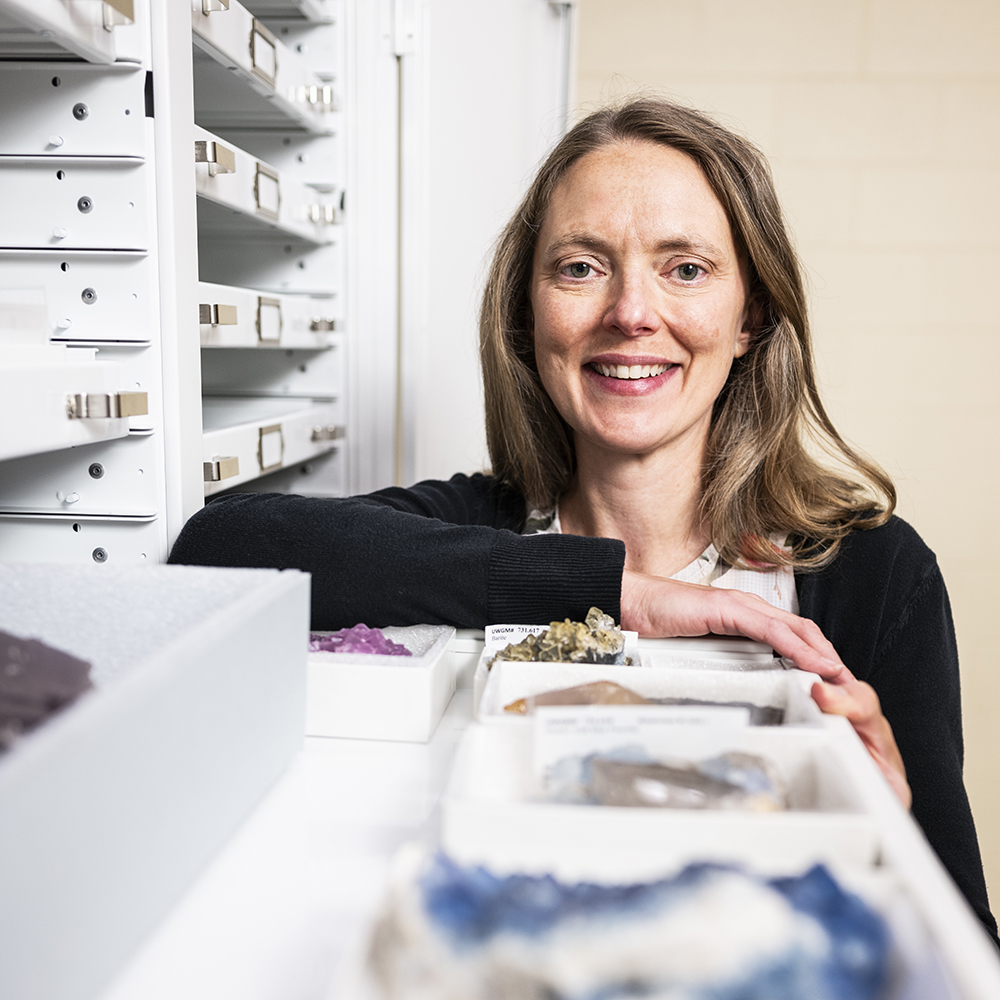
As curator, Eaton keeps track of the museum’s quarter of a million rocks, minerals, and fossils, most of which are in storage.
It’s Eaton’s job to keep track of all those tons. “I’m the museum’s data manager,” she says. “I migrated all of our digital data into a new collections management system, and I’m constantly cleaning and refining that to try to make all of this more findable, more accessible.”
She’s working on having digital images made of every item, and then on making sure that those images include the correct data.
“A collection that is 175 years old has 175 years’ worth of problems,” she says.
But it also has 175 years’ worth of stories. To celebrate the museum’s anniversary, Eaton and her colleagues decided to present one new exhibit each month between October 2023 and October 2024: the Pine River meteorite last October, a sparkly cluster of grape agate in November, a fossilized starfish in December, evidence of a 1.85 billion-year-old asteroid impact in January, the antlers of an extinct giant stag moose in February, a trio of trilobites in March, and in April, the Vienna meteorite. (14) That last item was discovered by Jim Koch in 2009, when his plow struck it. He and his spouse, Jan Shepel, decided to donate most of it to the museum.
“I love that it was found on a farm by Wisconsin farmers,” says Eaton. “And I think it’s important to maintain that connection with the public and show that anybody out there has the capacity or the ability to contribute something special to the museum.”
After the meteorite went on display in April, Eaton and the museum staff celebrated and then turned to thinking about May’s new exhibit, and June’s, and on until October. Eaton and her student employees keep on shipping and receiving new material, polishing and preparing it, and cataloguing its stories.
“I would argue I’m the museum’s biggest fan,” she says. “But I’d probably fight for that status amongst my peers.”
John Allen is associate publisher for On Wisconsin. We don’t know who he associates with.
Published in the Fall 2024 issue
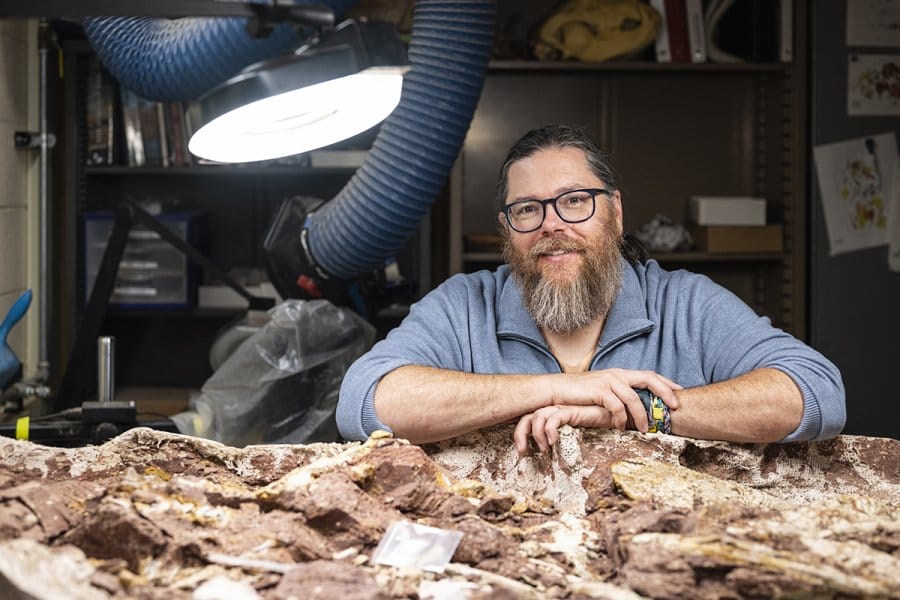
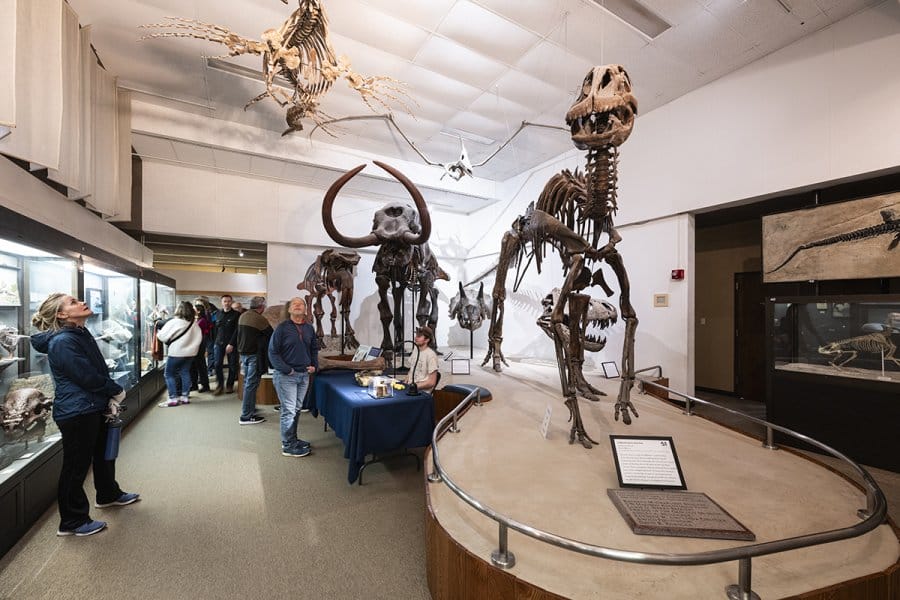

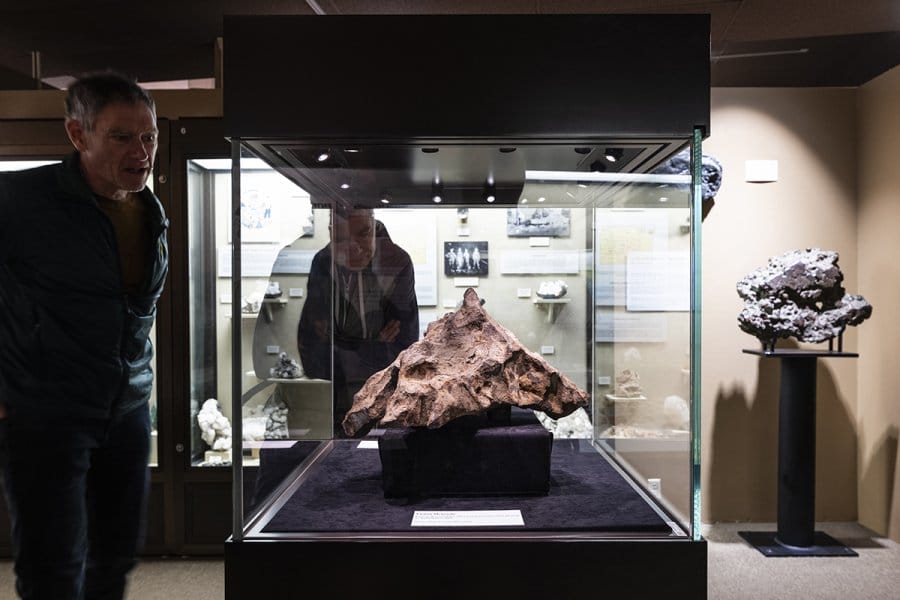
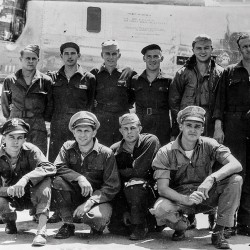
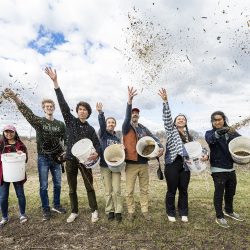
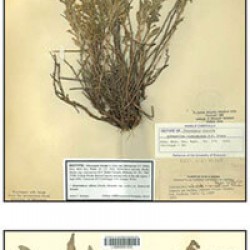
Comments
Eric Liebl September 9, 2024
Great story. I loved visiting the Geology museum (alone and with my kids). One lingering question though. If most of the Vienna meteorite was donated by Mr Koch and Ms Shepel, why was a $30,000-plus fund raising effort needed?
Andrea Renada September 17, 2024
Fabulous article! I love the personal tone it presents. It makes me want to visit the museum and talk to everyone who has a hand in running it to catch some of their passion.
Also, “We don’t know who he associates with,” had me laughing.
Curtis Grosskopf October 4, 2024
As a student in the 80’s, I would frequently study in the Geology Library, as it was little used and very quiet. And almost every time that I would study there, I would spend a little time walking through the Geology Museum. To me it was just such a fascinating collection.
Many years later when in Madison with my wife and daughters, they too enjoyed a visit to the museum.
So glad to hear it is in so many “good hands”.
John Haugen October 4, 2024
I enjoyed the article very much. I took the intro Geology course when I was a UW student in the ’60s and have been interested in Geology ever since.
I plan to visit the museum next time in town.
Rick DiMaio November 22, 2024
I graduated in 1985 from the department of Meteorology. I would often take a quick 10 to 15 minute break between classes just walking through the museum. So many students would walk across campus and never know about this hidden gem! When I visited the Meteorology Building over the summer, the first thing I did was stop by the museum! Love it!
Barney Veres January 14, 2025
I’m hooked. My son is a student at UW and the next time I’m there I can’t wait to visit this museum, and I’m sure the rest of the family will be in tow. Great article.